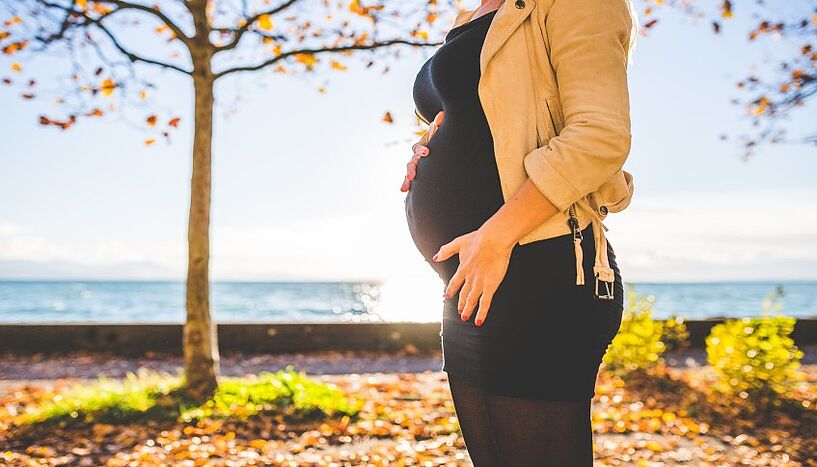Why do humans possess a twisted birth canal?
29. Oktober 2021
The relatively narrow human birth canal presumably evolved as a "compromise" (©pixabay)
Extraordinary shape makes births more difficult, but guarantees stability
The relatively narrow human birth canal presumably evolved as a "compromise" between its abilities for parturition, support of the inner organs, and upright walking. But not only the size of the birth canal, also its complex, "twisted" shape is an evolutionary puzzle. Katya Stansfield from the University of Vienna and her co-authors have published a study in BMC Biology presenting new insights into why the human birth canal evolved to have this complex shape. They suggest that the longitudinally oval shape of the lower birth canal is beneficial for the stability of the pelvic floor muscles.
In most women, the upper part, or inlet, of the birth canal has a round or transversely (left-to-right) oval shape, which is considered ideal for parturition, but it is unknown why the lower part of the birth canal has a pronounced longitudinally (front-to-back) oval shape. This twisted shape typically requires the Baby to rotate when passing through the narrow birth canal, which further increases the risk of birth complications.
In comparison with humans, apes have a relatively easy birth pattern that does not require rotation of the baby thanks to the longitudinally oval shape of the birth canal both at its inlet and the outlet. "For giving birth, it would be much easier to have a uniformly shaped birth canal also in our species", says Katya Stansfield, a specialist in biomechanics. Instead, the twisted human shape requires a complex, rotational birth mechanism: The baby needs to rotate to align the longest dimension of its head with the widest dimension of each plane of the birth canal. Misalignment can lead to obstructed labour and result in health risks for both mother and baby.
A research team of evolutionary biologists and engineers from the University of Vienna, the Konrad Lorenz Institute for Evolution and Cognition Research in Klosterneuburg and the University of Porto hypothesised that the support function of the pelvic floor muscles, which are suspended across the lower pelvis and also play an important role in sexual function and continence, may have influenced the evolution of the shape of the birth canal. The team carried out extensive biomechanical modelling of the pelvic floor and found that the highest deformation, stress, and strain occur in pelvic floors with a circular or transverse-oval shape, whereas a longitudinally oval elongation increases pelvic floor stability. "Our results demonstrate that the longitudinally oval lower birth canal is beneficial in terms of stability", says Katya Stansfield. "However, this outcome prompted us to ask why the pelvic inlet in humans is not also elongated longitudinally", elaborates Barbara Fischer, an evolutionary biologist.
Traditionally, it has been assumed that the transverse dimension of the human pelvis is constrained by the efficiency of upright locomotion. "We argue that the transverse elongation of the pelvic inlet has evolved because of the limits on the front-to-back diameter in humans imposed by balancing upright posture, rather than by the efficiency of the bipedal locomotion", says Philipp Mitteroecker, who was also involved in this study. A longitudinally deeper inlet would require greater pelvic tilt and lumbar lordosis, which would compromise spine health and the stability of upright posture. These different requirements of the pelvic inlet and outlet likely have led to the evolution of a twisted birth canal, requiring human babies to rotate during birth.
Publication in BMC Biology:
Stansfield, E., Fischer, B., Grunstra, N.D.S. Vila Pouca, M., Mitteroecker, P. The evolution of pelvic canal shape and rotational birth in humans.(2021)
Wissenschaftlicher Kontakt
Dr. Katya Stansfield
Department für Evolutionsbiologie, Unit für Theoretische BiologieUniversität Wien
1090 - Wien, Althanstraße 14
katya.stansfield@univie.ac.at
Philipp Mitteröcker
Department für EvolutionsbiologieUniversität Wien
1090 - Wien, Althanstraße 14
+43-1-4277-567 05
philipp.mitteroecker@univie.ac.at
Rückfragehinweis
Mag. Alexandra Frey
Media Relations ManagerUniversität Wien
1010 - Wien, Universitätsring 1
+43-1-4277-17533
+43-664-8175675
alexandra.frey@univie.ac.at
